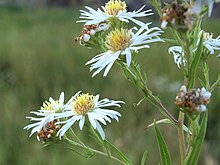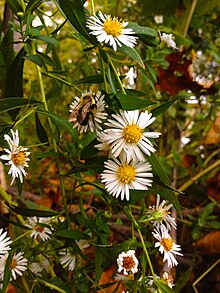
Symphyotrichum is a genus of over 100 species and naturally occurring hybrids of herbaceous annual and perennial plants in the composite family, Asteraceae, most which were formerly treated within the genus Aster. The majority are endemic to North America, but several also occur in the West Indies, Central and South America, as well as in eastern Eurasia. Several species have been introduced to Europe as garden specimens, most notably New England aster and New York aster.
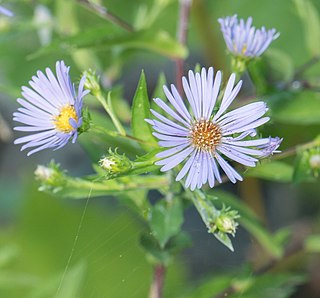
Symphyotrichum puniceum, is a species of flowering plant in the family Asteraceae native to eastern North America. It is commonly known as purplestem aster, red-stalk aster, red-stemmed aster, red-stem aster, and swamp aster. It also has been called early purple aster, cocash, swanweed, and meadow scabish.

Symphyotrichum ericoides, known as white heath aster, frost aster, or heath aster, is a species of flowering plant in the family Asteraceae native to much of central and eastern North America. It has been introduced to parts of Europe and western Asia.

Symphyotrichum lateriflorum is a species of flowering plant in the aster family (Asteraceae). Commonly known as calico aster, starved aster, and white woodland aster, it is native to eastern and central North America. It is a perennial and herbaceous plant that may reach heights up to 120 centimeters and widths up to 30 centimeters.

Symphyotrichum ascendens is a species of flowering plant in the family Asteraceae known by the common names western aster, long-leaved aster, and Rocky Mountain aster. Blooming July–September, it is native to western North America and can be found at elevations of 500–3,200 m (1,600–10,500 ft) in several habitats.

Symphyotrichum defoliatum is a species of flowering plant in the family Asteraceae known by the common name San Bernardino aster. It is endemic to Southern California where it grows in grasslands and meadows, and it is of conservation concern.

Symphyotrichum eatonii is a species of aster known by the common name Eaton's aster. It is native to much of western North America from British Columbia to Saskatchewan, the Sierra Nevada in California, the Rocky Mountains region, to Arizona and New Mexico, where it grows in many habitats, especially wet areas such as meadows and near ditches.

Symphyotrichum pilosum is a perennial, herbaceous, flowering plant in the Asteraceae family native to central and eastern North America. It is commonly called hairy white oldfield aster, frost aster, white heath aster, heath aster, hairy aster, common old field aster, old field aster, awl aster, nailrod, and steelweed. There are two varieties: Symphyotrichumpilosum var.pilosum, known by the common names previously listed, and Symphyotrichumpilosum var.pringlei, known as Pringle's aster. Both varieties are conservationally secure globally and in most provinces and states where they are native.

Symphyotrichum falcatum is a species of flowering plant in the family Asteraceae. Commonly called white prairie aster and western heath aster, it is native to a widespread area of central and western North America.

Symphyotrichum dumosum is a species of flowering plant of the family Asteraceae commonly known as rice button aster and bushy aster. It is native to much of eastern and central North America, as well as Haiti and Dominican Republic. It is a perennial, herbaceous plant that may reach a height of 1 meter.
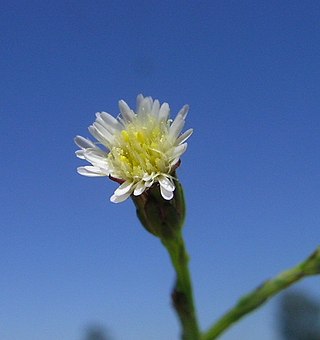
Symphyotrichum subulatum, commonly known as eastern annual saltmarsh aster or, in Britain and Ireland where it is naturalized, annual saltmarsh aster, is an annual plant in the family Asteraceae native to the eastern United States and the Gulf Coast to Texas. The species grows primarily in coastal salt marshes, although in the Ozarks it occurs as a non-marine weedy variety.

Symphyotrichum praealtum, known as willowleaf aster and willow aster, is a species of flowering plant in the aster family Asteraceae. It is native to North America and introduced in Europe.
John Cameron Semple is a botanist, cytotaxonomist, professor emeritus, and adjunct professor at the University of Waterloo in Ontario, Canada. He was born in Boston and earned a degree of Bachelor of Science in 1969 from Tufts University, followed in 1971 and 1972 by Master of Arts and Doctor of Philosophy degrees from Washington University in St. Louis. Semple is known for his work with members of the tribe Astereae, particularly goldenrods, American asters, and goldenasters, and he maintains the University of Waterloo Astereae Lab website. Semple's wife is Brenda, and in 2013, he named a newly discovered goldenrod species Solidago brendiae in honor of her.

Symphyotrichum racemosum is a species of flowering plant native to parts of the United States and introduced in Canada. It is known as smooth white oldfield aster and small white aster. It is a perennial, herbaceous plant in the family Asteraceae. It is a late-summer and fall blooming flower.

Symphyotrichum drummondii is a species of flowering plant of the family Asteraceae native to the central and eastern United States. Commonly known as Drummond's aster, it is a perennial, herbaceous plant that may reach 120 centimeters in height.
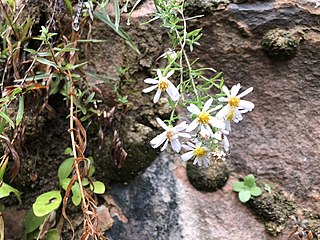
Symphyotrichum welshii is an imperiled species of flowering plant of the aster family (Asteraceae) endemic to only certain western states in the United States, specifically Arizona, Idaho, Montana, Utah, and Wyoming, and is found at elevations of 1,300–2,300 meters. It is perennial and herbaceous and may reach a height of 1 meter. Its bloom time is August–October, and it grows in wet soils that occur in dry areas.
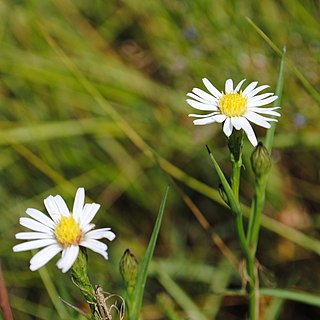
Symphyotrichum tenuifolium is a species of flowering plant in the family Asteraceae and is commonly known as perennial saltmarsh aster. It is a perennial and herbaceous plant native to the eastern United States and the West Indies. There is one variety, S. tenuifolium var. aphyllum in addition to the autonym S. tenuifolium var. tenuifolium.
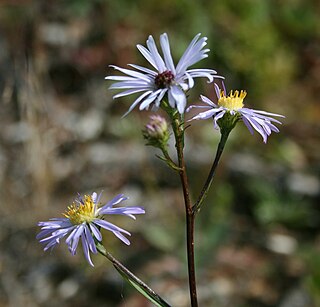
Symphyotrichum foliaceum is a species of flowering plant in the family Asteraceae native to western North America. Commonly known as leafy aster, leafy-bracted aster, and alpine leafybract aster, it is a perennial, herbaceous plant that may reach 10 to 60 centimeters in height. Its flowers have violet to purple ray florets and yellow disk florets. Four varieties were accepted as of July 2021 by Plants of the World Online (POWO), as follows: S. foliaceum var. apricum, S. foliaceum var. canbyi, S. foliaceum var. cusickii, and S. foliaceum var. parryi. The autonym is S. foliaceum var. foliaceum.

Symphyotrichum spathulatum is a species of flowering plant in the family Asteraceae native to western North America including northwestern Mexico. Commonly known as western mountain aster, it is a perennial, herbaceous plant that may reach 20 to 80 centimeters tall. Its flowers, which open in July and August, have violet ray florets and yellow disk florets.



